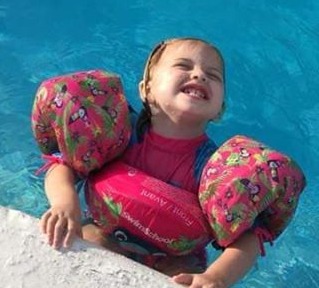"Ditch the Floaties": the Dangers of the Popular "Puddle Jumper"
- PPCD
- Jul 21, 2021
- 4 min read
Many non-profit organizations who specialize in drowning prevention tell you to “ditch the floaties” and teach your child how to swim and self-rescue instead. This is because there have been countless instances in which a child has removed this device during a swim time and returned to the pool unnoticed, leading to a drowning accident. (See Judah Brown Project, Kourtney’s Kause)
But what about times when your child is not expected to be swimming? Let's take a close scientific look into why puddle jumpers may be contributing to toddler drownings during non-swim times.
First of all, you may be asking “how can a device that is approved by the Coast Guard be dangerous?”

The Coast Guard approves devices for open water: natural bodies of water like lakes, rivers, and oceans where water conditions are unstable. They do not approve devices for use in swimming pools and definitely they do not deem a device to be a “learn to swim” aid. These devices have a place, the swimming pool is not one of them.
Children learn through positive reinforcement. This is directly observed in our “water baby culture”. Our society is proud of our water babies. We love how they are brave and fearless in the water, and how much fun they have. Praise and encouragement from parents help shape this behavior. Toddlers are too young to understand the risks of the water, especially if we are reinforcing fun, confidence and safety with the use of a puddle jumper.
The main problem with the puddle jumper is when the child who routinely wears this device while swimming confidently returns to the water without it.
The science behind this bias:
Statistics show over two-thirds (69%) of fatal drownings for children aged between 1 and 4 years occur during a non-swim time. Most of these drownings occur within 5 minutes of being observed safe, away from water.
Erik Erikson, a well known child psychologist, identifies eight stages of psychosocial development. The first state is Trust vs. Mistrust, which occurs at birth to about 18 months of age. This is when the child begins to trust the world around them. With positive reinforcement from parents and the use of the puddle jumper, we are reinforcing trust in the water. We are teaching children the water is a fun and safe place by making them comfortable and giving them confidence, but not giving them the skills to survive in the water.
The second stage Erikson identifies is Autonomy vs. Shame and Doubt which typically occurs from 18 months of age to 3 years old. This stage is directly built from what they have learned to trust in the first stage. The question becomes “can I do things myself or am I reliant on the help of others?” Many parents unknowingly use the puddle jumper as a substitute for their child knowing how to swim. But bobbing around in the water independently while their parent sits on the pool deck conveys to the child that swimming is easy and fun, no parent needed.
When the child has accepted the pool as a fun and safe place, they may think it is safe for them to jump in by themselves. At this age, they do not have the cognitive abilities to understand this relationship. In their little minds, they are invincible. For children who routinely wear the puddle jumper, this could lead to a fatal drowning accident as they have not developed a healthy respect for the water.
Children learn through their senses and motor movements. The puddle jumper positions your child to swim in an upright, vertical position. When the child routinely swims with the puddle jumper it can condition your child to believe that is the position they should be when they are swimming. This creates a "muscle memory", or specifically a memory in the neurons of their brain, for the child to return to this vertical position, with or without the device.
Treading water, a vertical position with their head out of the water to breathe, is nearly impossible for a child to maintain under the age of 4. This is because of their anatomy. The heads of young children are much larger in respect to the rest of their body compared to older children and adults. They will try to maintain this position, attempting to raise their head to breathe, but will be unsuccessful.

Furthermore, puddle jumpers as a “learn to swim device” could not be further from the truth. Children who wear these devices often develop a kick that is similar to riding a bicycle. The bulkiness of the device around the arms impedes them from strokes. And since their head remains out of the water when wearing the device, they can develop an aversion to having water on their face and in their ears.
Our culture surrounding young children and water has it all wrong. This includes the use of “puddle jumpers” . We are giving young children a tool that makes them feel safe and confident in the statistically most dangerous environment for them to be. DITCH THE FLOATIES. Teach your children how to float on their backs. Swim together using touch supervision. Don’t let them think they can enter the pool without you.

Please consider my advice. I am one of the thousands of parents who had to learn the hard way. Go ahead, take off their puddle jumper and watch what happens (under supervision of course). Then look into a high quality swimming program that will teach your child how to survive in the water.






